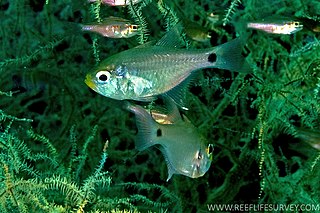
Cardinalfishes are a family, Apogonidae, of ray-finned fishes found in the Atlantic, Indian, and Pacific Oceans; they are chiefly marine, but some species are found in brackish water and a few are found in fresh water. A handful of species are kept in aquariums and are popular as small, peaceful, and colourful fish. The family includes about 370 species.

Apogon is a large genus of fish in the family Apogonidae, the cardinalfishes. They are among the most common fish on coral reefs. Over 200 species have been classified in genus Apogon as members of several subgenera. Some of these subgenera, such as Ostorhinchus, have been elevated to genus status, leaving just over 50 species in the genus.

Nectamia is a genus of cardinalfishes native to the Indian Ocean and the western and central Pacific Ocean.

Astrapogon is a genus of cardinalfishes native to the western Atlantic Ocean.

Apogonichthyoides is a genus of fish in the family Apogonidae, the cardinalfishes. They are native to the Indian Ocean and the western Pacific Ocean.

Cercamia is a genus of fishes in the family Apogonidae, the cardinalfishes. They are native to the Pacific and Indian Oceans.

Cheilodipterus is a genus of fishes in the family Apogonidae, the cardinalfishes. They are native to the Indian Ocean and the western Pacific Ocean.

Foa is a genus of fishes in the family Apogonidae, the cardinalfishes, native to the Indian and Pacific Oceans.

Fowleria is a genus of fishes in the family Apogonidae native to the Indian and Pacific Oceans. The name of this genus honors the American ichthyologist Henry Weed Fowler ( ) of the Academy of Natural Sciences of Philadelphia, who attended Stanford University, where he was a student of David Starr Jordan's.
Lachneratus phasmaticus, also known as the phantom cardinalfish, is a species of fish in the family Apogonidae, the cardinalfishes. It is the only member of its genus. It is native to the tropical eastern Pacific and Indian Oceans. This fish can be found in crevices and underwater caves, and it occurs at depths of 3 to 104 m. It grows to a standard length of 7.4 cm (2.9 in).
Neamia is a genus of cardinalfishes native to the Indian Ocean and the western Pacific Ocean.

Ostorhinchus is a genus of ray-finned fish in the family Apogonidae native to the Indian and Pacific Oceans.

Phaeoptyx is a genus of cardinalfishes native to the western Atlantic Ocean.

Pristicon is a genus of cardinalfishes native to the western Pacific Ocean.
Pseudamia is a genus of cardinalfishes native to the Indian and Pacific oceans.
Pseudamiops is a genus of cardinalfishes native to the Pacific and Indian oceans.

Siphamia is a genus of cardinalfishes native to the Indian and Pacific Ocean. Several of these species are commensal with various species of sea urchins.

Zoramia is a genus of cardinalfishes native to the Indian and Pacific Ocean.

Archamia bleekeri, also known as Gon's cardinalfish, is a species of fish in the family Apogonidae, the cardinalfishes. It is native to the coastal waters of the Indian Ocean and the western Pacific Ocean from Africa to Indonesia and from Taiwan to Queensland, Australia. This species occurs in mangrove forests and reefs, and is an inhabitant of shipwrecks, preferring silty areas with muddy or sandy substrates. This species grows to a total length of 10 cm (3.9 in). This species is the only member of the genus Archamia. The other species were moved to the new genus Taeniamia in 2013.

Pristiapogon exostigma, also known as Eyeshadow cardinalfish or oneline cardinalfish, is a small pale ray-finned fish from the family Apogonidae, the cardinalfishes with light-ended black stripe ending in black spot above centre of stripe. It has an Indo-Pacific range which extends from the Red Sea to the Line Islands and Mangareva Islands and south to northern Australia and north to the Ryukyu Islands.
















